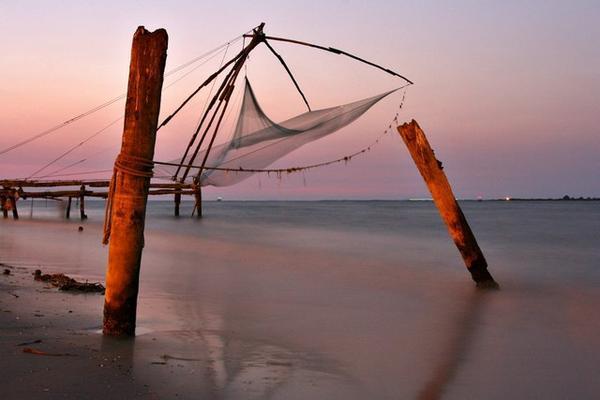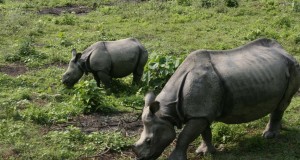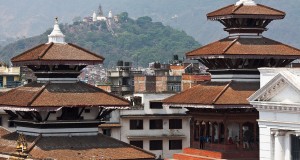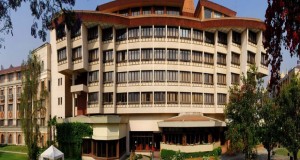Fort Cochin and Mattancherry have the historical sites; modern Ernakulam has the bus and rail stations, the hotels, shops and restaurants; Willingdon Island is the site of the airport, the two top hotels, and the tourist office; 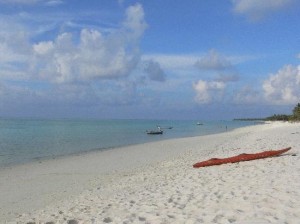 Boighatty has its famous palace hotel; and Gundu its interesting coir factory. Most travellers stay in Ernakulam. It may be a busy, unrelaxing commercial centre, but it’s certainly the best base for sightseeing. All Cochin’s islands are linked by a regular ferry service, operating from Ernakulam’s three jetties.
Boighatty has its famous palace hotel; and Gundu its interesting coir factory. Most travellers stay in Ernakulam. It may be a busy, unrelaxing commercial centre, but it’s certainly the best base for sightseeing. All Cochin’s islands are linked by a regular ferry service, operating from Ernakulam’s three jetties.
The main jetty charges Rsl for trips over to Willingdon, Vypeen, Vallarpadam and Fort Cochin (either to Chinese Fishing Nets, or to Dutch Palace) islands. The High Court jetty, at the top of Shanmugham Rd, has ferries to Boighatty island. And the Sealord jetty, near Sealord Hotel, is the venue for twice-daily KSTDC boat trips round all the islands (see General Information below). These latter excursions are an excellent way of covering Cochin’s many sights in a single day.
To get around Ernakulam itself, you have a choice of auto-rickshaws, which don’t use meters (establish your fare in advance) or taxis. If staying at Fort Cochin, which has limited but pleasant accommodation, the most enjoyable way of getting round is by cycle. There are several bike-hire places, charging around Rs10 per day.
Cochin Islands Tour (conducted tour boat, half-day)
Mattancherry Palace-Jewish Synagogue-Chinese Fishing-nets- St Francis Church-Santa Cruz Church-Bolghatty Palace-Gundu Island Get a sun-deck seat aboard the 9.30 am KTDC sightseeing boat leaving daily from Sealord jetty. (This is cooler than the 1.30 pm departure.) The tour passes by Willingdon Island, off which are moored giant cargo ships loaded with fertiliser, chemicals and palm oil, and makes its first stop at Mattancherry Palace in Fort Cochin.
Presently administered by the Archaeological Survey of India, this large white, red-roofed structure has an interesting history. Built by the Portuguese around 1555 and presented to Raja Veera Kerala Varma (1537-61) as a goodwill token in exchange for trading rights. It was later renovated by the Dutch in 1663 and gained the misnomer of 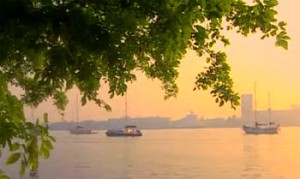 the ‘Dutch Palace’. An interesting combination of Kerala and Dutch building styles, it stands in a walled garden enclosure fronted by a tank, backing onto mango groves and three Hindu temples. The palace is built on two floors and around a central quadrangle. Inside the palace, see the large central Durbar Hall, where the Cochin royal family held their coronation ceremonies. Here you’ll find an assortment of their palanquins, weapons, dresses and turbans. The adjacent series of royal bedrooms and other chambers have some fine murals. Covering a wall area of nearly 305 m, the 45 murals date from the 17th century and depict scenes from the Rarnayana epic, also the Puranic legends relating to Shiva, Vishnu, Krishna, Kumara and Durga. Vigorous, fresh and delightfully sensual; one can’t help but notice Shiva’s eight arms busily at work on eight grateful handmaidens. Unfortunately you cannot photograph them without permission from the Archaeological Survey, and there are no books or postcards for sale. The Dutch Palace is open 10 am-5 pm daily, except Friday.
the ‘Dutch Palace’. An interesting combination of Kerala and Dutch building styles, it stands in a walled garden enclosure fronted by a tank, backing onto mango groves and three Hindu temples. The palace is built on two floors and around a central quadrangle. Inside the palace, see the large central Durbar Hall, where the Cochin royal family held their coronation ceremonies. Here you’ll find an assortment of their palanquins, weapons, dresses and turbans. The adjacent series of royal bedrooms and other chambers have some fine murals. Covering a wall area of nearly 305 m, the 45 murals date from the 17th century and depict scenes from the Rarnayana epic, also the Puranic legends relating to Shiva, Vishnu, Krishna, Kumara and Durga. Vigorous, fresh and delightfully sensual; one can’t help but notice Shiva’s eight arms busily at work on eight grateful handmaidens. Unfortunately you cannot photograph them without permission from the Archaeological Survey, and there are no books or postcards for sale. The Dutch Palace is open 10 am-5 pm daily, except Friday.
Just a few hundred yards south is the oldest Jewish Synagogue in the Commonwealth. The present structure was built in 1568, destroyed by the Portuguese in 1662, rebuilt by the Dutch in 1664, and donated its 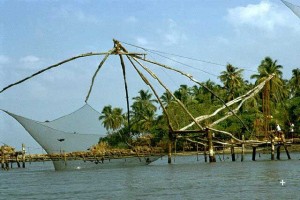 distinctive clock tower by Ezekiel Rahabi, a wealthy Jewish trader, in the mid-18th century. He also provided its exquisite willow-pattern floor tiles, each handpainted in a different design, brought over from Canton in 1776. The synagogue interior is fascinating: 19th-century Belgian chandeliers, interlocking pews, a ladies’ gallery, and a superbly crafted brass pulpit. The curator, Jacky Cohen, shows visitors around and gives full information. He can also sometimes be prevailed upon to show the synagogue’s two most prized treasures: the Great Scrolls of the Old Testament, and the copperplate grants of privilege made by the Cochin Maharajahs (962-1020) to the Jewish merchant Joseph Rabban. Nowadays, the place has a rather empty feel: all but 27 of Cochin’s Jews have left; many have migrated to Israel. The Synagogue is open 10 am-noon, 3-5 pm, daily except Saturday. Admission is Rsl.
distinctive clock tower by Ezekiel Rahabi, a wealthy Jewish trader, in the mid-18th century. He also provided its exquisite willow-pattern floor tiles, each handpainted in a different design, brought over from Canton in 1776. The synagogue interior is fascinating: 19th-century Belgian chandeliers, interlocking pews, a ladies’ gallery, and a superbly crafted brass pulpit. The curator, Jacky Cohen, shows visitors around and gives full information. He can also sometimes be prevailed upon to show the synagogue’s two most prized treasures: the Great Scrolls of the Old Testament, and the copperplate grants of privilege made by the Cochin Maharajahs (962-1020) to the Jewish merchant Joseph Rabban. Nowadays, the place has a rather empty feel: all but 27 of Cochin’s Jews have left; many have migrated to Israel. The Synagogue is open 10 am-noon, 3-5 pm, daily except Saturday. Admission is Rsl.
The tour boat proceeds to the northern tip of Fort Cochin, where huge, cantilevered fishing-nets proclaiming the ancient trade connections with China are ranged along the water’s edge like a string of filigree lace handkerchieves. Probably introduced by traders from the court of Kublai Khan, these fascinating nets are still an efficient method of fishing. While not unique to Cochin, the nets flanking the opening to the harbour are perhaps the best place in Kerala to see them at work.
A short walk below the nets is St Francis Church, believed to be the first European church 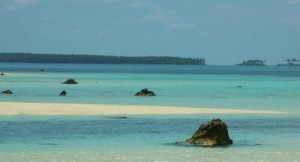 to be built in India. The original structure, presumably built by Portuguese Franciscan friars in 1503, was of wood. Later, during the mid-16th century, it was rebuilt in stone. Over the years it has experienced a number of ‘conversions’ from Catholic Portuguese, to Protestant Dutch, to Anglican before achieving its present status as the Church of south India. The exterior is notable for its impressive facade, and there’s an array of interesting Portuguese and Dutch tombstones including that of Vasco Da Gama, who died here in 1524 although his body was taken to Portugal 14 years later. Should you wish to leave the tour at this point, a short walk inland brings you to Santa Cruz Cathedral.
to be built in India. The original structure, presumably built by Portuguese Franciscan friars in 1503, was of wood. Later, during the mid-16th century, it was rebuilt in stone. Over the years it has experienced a number of ‘conversions’ from Catholic Portuguese, to Protestant Dutch, to Anglican before achieving its present status as the Church of south India. The exterior is notable for its impressive facade, and there’s an array of interesting Portuguese and Dutch tombstones including that of Vasco Da Gama, who died here in 1524 although his body was taken to Portugal 14 years later. Should you wish to leave the tour at this point, a short walk inland brings you to Santa Cruz Cathedral.
This is a Roman Catholic structure, built in 1557, with a brilliantly-painted interior. Nearby, locals play polite games of cricket on the Surrey-style village green. Beyond this, walking up Calvetty St, you’ll find a medieval settlement of pastel houses, 16th-century Portuguese bastions and narrow alleys, and still more Catholic churches.
The tour continues on to Boighatty Island, to visit the Bolghatty Palace Hotel. Set in 15 acres of lush green lawns, this palatial structure started life as a Dutch palace, built 1744, and later became home of the British Resident to the Rajah of Cochin after 1799. Presently run as a hotel by the Kerala Tourism Development Corporation (KTDC), it has a golf course, a bar and a restaurant. From here, it’s just a short chug across the harbour to Gundu Island (look out for leaping dolphins), for shopping at its small Coir Factory. Here a busy co-operative workers’ society produce doormats handwoven from rough coconut fibre (coir) (Rs50-200). The weaving process is worth seeing.
Back in Ernakulam, off the boat, it’s a short walk to Durbar Hall Rd for Parishath Thamburan Museum in the old Durbar Hall. This has 19th-century paintings, copies of murals, old coins, delicate chandeliers, sculptures, musical instruments and lovely chinaware. The main attraction is the collection drawn from the Cochin royal family treasury. Open 9.30 am-12 pm, 3-5.30 pm daily, except Mondays.
RECREATION
No visit to Cochin is complete without seeing a performance of Kathakali, the famous dance-drama of Kerala. Kathakali started out some 2000 years ago as a temple art-form, depicting themes from the Raniayann and 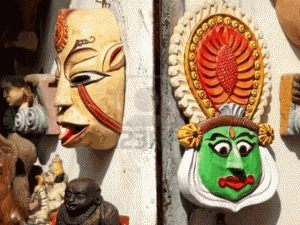 Mahabharata epics.. More an elaborate sequence of yogic exercises than a dance-form, Kathakali may seem slow and stylised compared to say, Bharatnatyam, but it has a grace and a charm all of its own. A unique ‘language’ of 24 separate gestures has evolved over the centuries, any combination of which conveys a definite meaning. The eyes are especially important, suggesting an immense range of differing moods and emotions. The costumes, wigs and masks used are bright and flamboyant, all made from natural materials. Make-up is distinctive with several layers of paint being applied to the dancer’s face to accentuate lips, eyebrows and eyelashes. The overall effect is highly dramatic.
Mahabharata epics.. More an elaborate sequence of yogic exercises than a dance-form, Kathakali may seem slow and stylised compared to say, Bharatnatyam, but it has a grace and a charm all of its own. A unique ‘language’ of 24 separate gestures has evolved over the centuries, any combination of which conveys a definite meaning. The eyes are especially important, suggesting an immense range of differing moods and emotions. The costumes, wigs and masks used are bright and flamboyant, all made from natural materials. Make-up is distinctive with several layers of paint being applied to the dancer’s face to accentuate lips, eyebrows and eyelashes. The overall effect is highly dramatic.
At present, Cochin has three Kathakali dance companies. They are Cochin Cultural Center (tel 353732), Durbar Hall Ground, D.H. Rd; See India Foundation (tea: 369471), Kalathiparambil Lane; and Art Kerala at Ravipuram Rd. All three places charge the same (Rs30, pay at the door), and shows start at either 6.30 pm (Cultural Centre) or 7 pm (See India and Art Kerala). Turn up early to see the dancers applying make-up backstage which you can photograph, and bring mosquito coils to place under your chair. 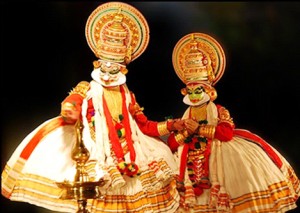 Of the three, the Cultural Centre has the best reputation, though Art Kerala puts on a wide range of Keralan dances (not just Kathakali), and See India gives the fullest, clearest explanations preceding each dance.
Of the three, the Cultural Centre has the best reputation, though Art Kerala puts on a wide range of Keralan dances (not just Kathakali), and See India gives the fullest, clearest explanations preceding each dance.
Other recreations include golf (9-hole course, Rs40 green fees include caddy, balls and clubs) and horse-riding at Boighatty Palace Hotel; and English films in air-conditioned comfort at the Sridhar cinema, near the KSTDC reception centre in Shanmugham Rd. The cool air-conditioned Devi cinema (Cochin’s best) in Mahatma Gandhi Road, Ernakulam, is the ideal escape on hot, sticky afternoons. So is the swimming-pool at the Malabar Hotel on Willingdon Island, open to non-residents (except Tuesday and Friday) for a daily charge of Rs50.
SHOPPING
Buy teas, spices (ginger, turmeric, cardamom, cumin and cloves) and cashew-nuts along the roadside leading down to Ernakulam main market. Because these pavement vendors sell their produce in the open, they can’t (unlike shops) adulterate them. Another good place to buy the famous Cochin spices at local prices is Grand Bazaar supermarket, at Abad Plaza Hotel in M.G. Rd. For fabrics, rosewood, walnut, Kathakali props and masks, and assorted jewellery, try the various emporia and shops along M.G. and Broadway roads.

